There was a time, not as long ago as it feels, when speed was nothing more than a competitive edge. But that was before the tools and technology available in the digital first world of today conditioned us to expect near instant results. Whether you’re rolling out a new feature, fixing a critical bug, or dealing with a security incident — moving fast while maintaining reliability is a defining factor of modern business models.
This shift in our mindset around speed — from luxury to necessity — has completely redefined how software gets built, tested, and delivered. It also challenged how teams work together. Because the traditional processes your development and operations departments used for handovers just couldn’t keep up with the demands of always-on services, regular releases, and real-time user feedback.
And that’s where DevOps came into the picture.
Born from the practical struggles of scaling both the web and high velocity businesses, and hardened through years of lived experience — DevOps grew and evolved into a professional philosophy shared by everyone from software developers to sales teams. So it’s more than just a job title, a tool, or even a process.
It’s a way of working.
One that has collaboration, automation, and continuous improvement at its core. And while it looks slightly different in every organisation, the primary goal is always the same: building and operating high-velocity systems that can adapt, scale, and succeed in a world that moves fast.
At EM360Tech, we’ve seen DevOps emerge again and again in conversations about speed, resilience, and scaling in the digital age — a response to the growing pressure to deliver fast without breaking things.
But what exactly is DevOps — and why is it transforming how we think about software, teams, and business itself?
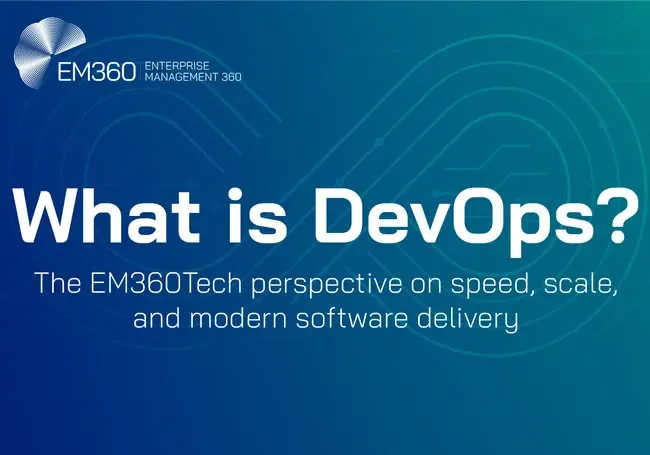
DevOps Defined
One of the best definitions of DevOps is that it’s a cultural and professional movement focused on how we build and operate high-velocity organisations, born from the experiences of its practitioners.
It brings people, processes, and tools together in a way that helps your teams deliver software faster, more reliably, and more collaboratively. But you won’t find a checklist or rigid set of rules you can follow like you do with traditional methodologies. Instead, it’s shaped by real-world practice — and it adapts to fit the needs of the organisation using it.
That’s part of what makes it so difficult to describe. Ask five people what DevOps means to them and you’ll probably get six different answers. Some will talk about automation or tooling. Others will describe it as a culture shift or a systems approach. None of them are wrong — but none of them capture the full picture either.
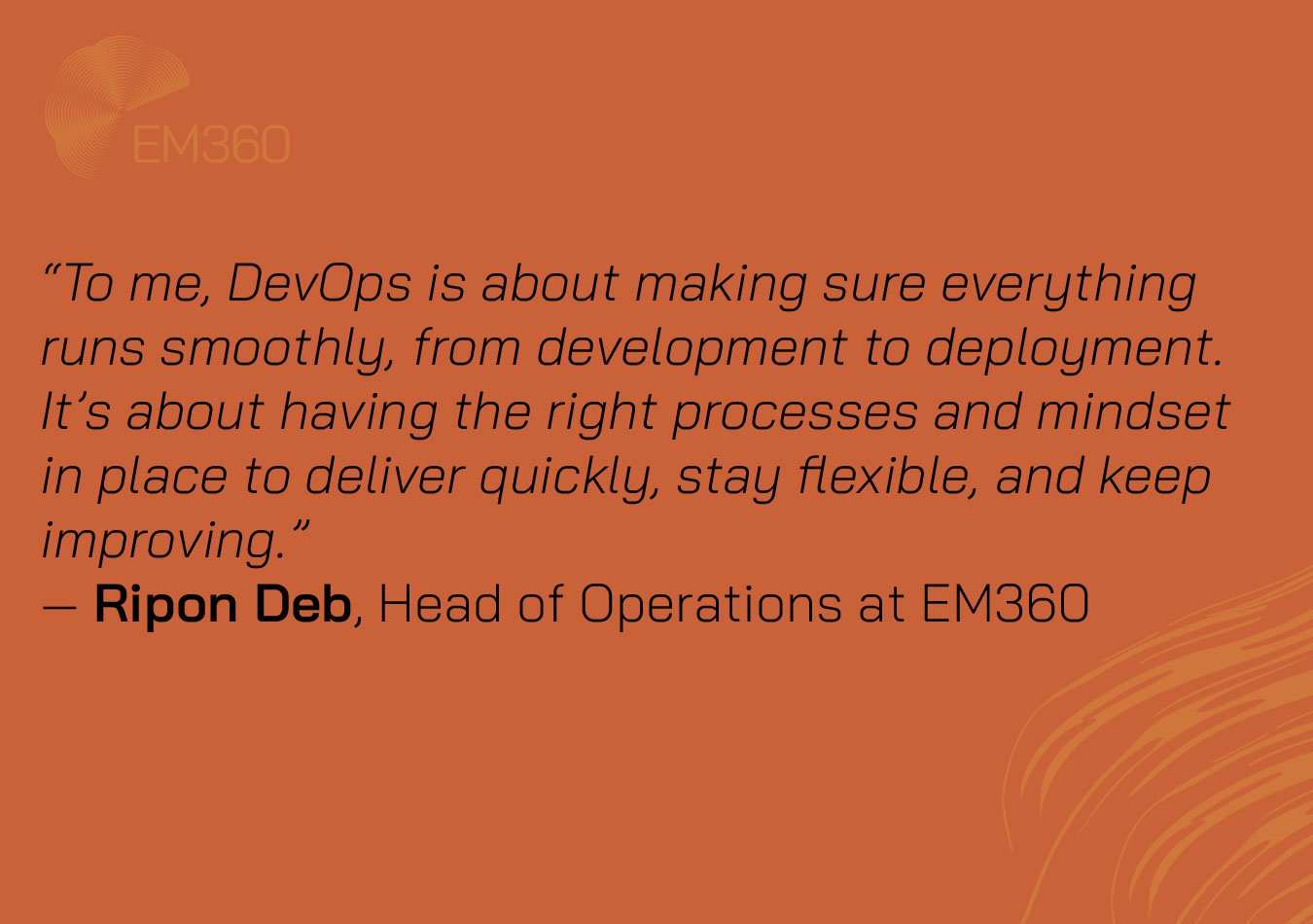
Here’s how some other industry voices have described it:
🟠 “As a platform engineer or DevOps engineer, we build toolchains and workflows that empower engineers to iterate effectively and provide a platform. We enable self-service capabilities to improve developer velocity and therefore speed up product to market which is the end goal.”
— Michael Morse, Cloud Architect at Slalom
🟢 “Full DevOps is that you are able to drive a code that’s easy to configure, have your infrastructure provisioned based on that code, and get ready to run an application.”
— James Chen, SVP & Executive President of Cloud and AI BU at H3C
🔵 “DevOps is a kind of domain that varies inside a company. We can't compare company to company... because here we’re talking about developing a culture.”
— Sachin Ohal, Startup Executive Advisor
But to really understand what DevOps is, it helps to first understand what it isn’t.
What DevOps isn’t
DevOps isn’t a job title or a tool — though you’ll find plenty of both in the wild.
And it isn’t a one-size-fits-all methodology. There’s no universal checklist, no out-of-the-box setup that guarantees DevOps success. That’s because DevOps is less about doing a specific thing and more about how and why things are done. It’s a philosophy expressed through systems, culture, and practice — and those look different at every company.
DevOps also isn’t limited to people with “engineer” in their job title. The mindset it requires — cross-functional thinking, feedback loops, shared accountability — is just as relevant to product managers, quality analysts, security leads, and yes, even business decision makers.
If you’ve ever found yourself working across teams to solve a problem faster, or iterating on a solution based on real-time feedback, you’ve already experienced what DevOps feels like — even if you never called it that.
What DevOps is
DevOps is both a culture and a discipline. It’s about creating an environment where people can build, ship, and support software quickly, safely, and collaboratively. Where the distance between idea and outcome is shortened — not just by better tooling, but by better habits.
At its best, DevOps brings together the fast-paced creativity of development with the stability and rigour of operations. It helps teams deliver value more reliably, respond to incidents more effectively, and improve continuously — without sacrificing speed or trust.
But more than that, DevOps is a mindset. A way of thinking that favours transparency over silos, shared goals over departmental targets, and progress over perfection.
That mindset doesn’t belong to one team. It belongs to the organisation.
And when it’s done right, it creates something much more powerful than a process. It builds a culture that ships better software — and a business that moves with purpose.
How DevOps Works
DevOps is often explained through the CAMS model: Culture, Automation, Measurement, and Sharing. It’s a simple, practical way to break down the foundational principles of DevOps into something actionable. But like most frameworks, it only goes so far. Real DevOps teams don’t just follow CAMS — they live it. They turn those pillars into habits. Disciplines. Practices refined through collaboration, trial and error, and the ongoing pressure to deliver.
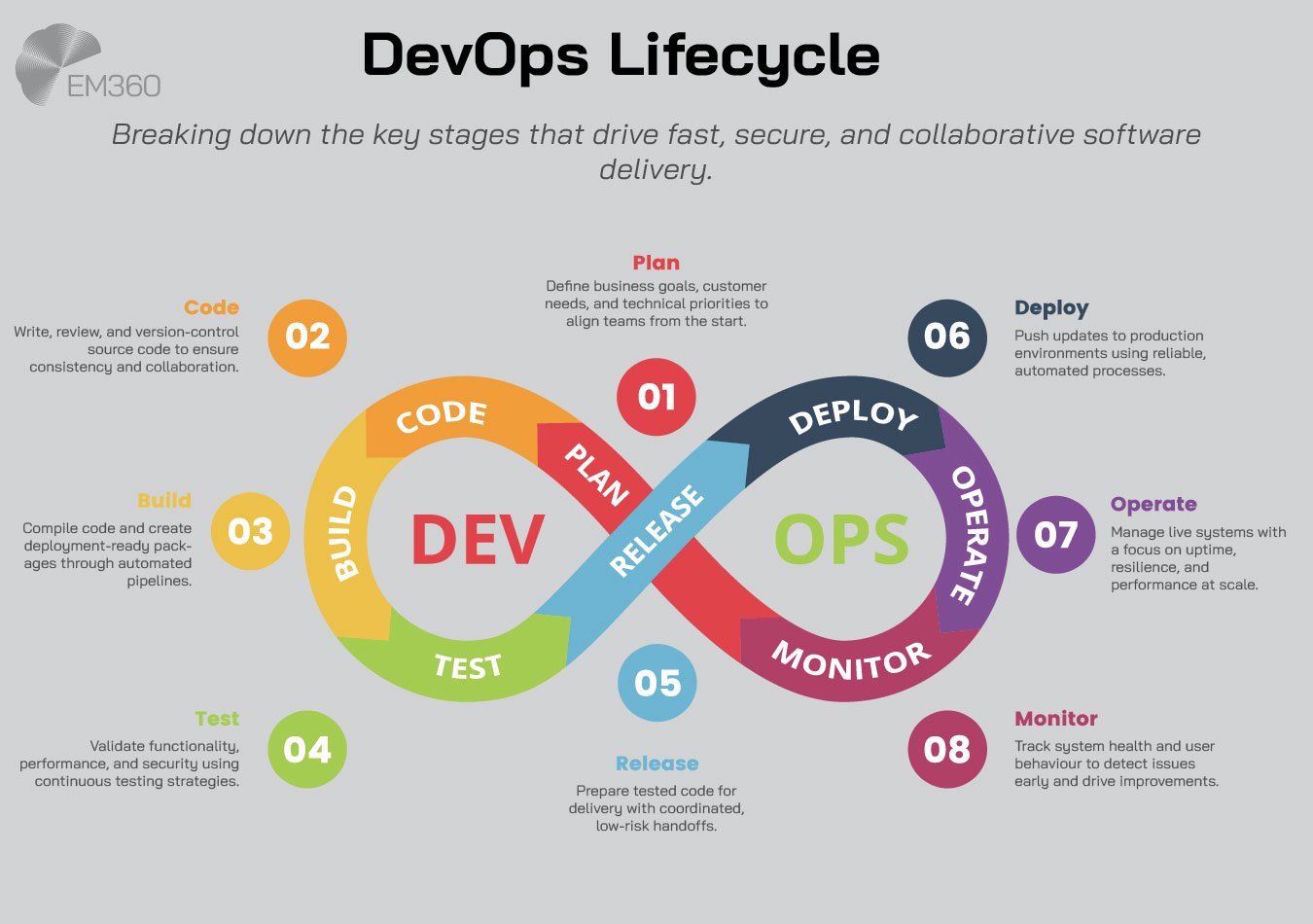
The CAMS model in practice
Anyone can know the acronym. But it’s how you put it into action that tells the real story.
🟩 Culture
Culture is where DevOps starts — and where it either succeeds or fails. The tools matter, but they’ll only take you so far if your teams don’t trust each other, if collaboration is forced, or if failure is punished instead of examined.
At its core, DevOps culture means creating an environment where people can work without fear. Where developers, operators, security specialists, and business leaders aren’t pulling in different directions, but sharing the same goals. Where safety, freedom, inclusion, and curiosity are valued just as much as speed.
That kind of culture doesn’t just happen. It has to be built — through transparent communication, consistent leadership, and shared accountability. When it’s done right, it changes everything. Silos fall. Feedback loops tighten. Teams move with clarity instead of friction.
🟦 Automation
Automation is what makes speed sustainable. But in DevOps, automation isn’t about cutting corners. It’s about building confidence — and making the right thing the easy thing.
Think CI/CD pipelines that automatically test and deploy new code. Infrastructure as Code (IaC) that ensures every environment is consistent. Monitoring systems that flag issues before users notice them. DevOps teams don’t automate for the sake of it — they automate to protect the flow of delivery and free up their people to focus on what matters.
It’s the difference between manually flipping the same switch every day and building a system that flips it for you — accurately, reliably, and without burning out the team.
Or to borrow a favourite analogy: you could fry doughnuts one by one and hope for consistency. Or you could build a doughnut machine that produces perfect golden rings every time. Automation in DevOps isn't about replacing people — it’s about scaling quality without losing the integrity of good software practices
🟨 Measurement
High-performing teams measure what matters. Not just because dashboards are nice to look at, but because you can’t improve what you don’t understand.
In DevOps, measurement isn’t about assigning blame. It’s about visibility. It’s knowing when the system is straining before it breaks. It’s tracking how fast teams recover from failure — not just how often they deploy. And it’s making those insights available to everyone, not locking them behind ops or engineering.
Metrics don’t make a system perfect. But they help teams orient themselves in complexity — to recognise patterns, validate assumptions, and adapt with purpose. The goal isn’t zero failure. It’s faster learning.
🟥 Sharing
The “S” in CAMS is sometimes overlooked — but it’s what turns a group of individuals into a DevOps team. Sharing means more than documentation or tooling. It’s the active flow of knowledge, context, and trust across every part of the organisation.
In strong DevOps environments, developers share context with operations departments. Security shares concerns with the engineers. Sales shares user insights with the product team. And leadership shares the broader vision that ties it all together.
You can’t script that. You build it — through relationships, trust, and a culture that values openness over hierarchy. It’s the difference between knowing how to use a tool and knowing when, why, and with whom.
Because in DevOps, everyone has a role to play — not just in delivery, but in learning, adapting, and improving the system together.
The application — why DevOps looks different everywhere
If you walk into ten different organisations practising DevOps, you’ll see ten different implementations. And that’s exactly how it should be.
A global bank will have different constraints and compliance requirements than a startup shipping product updates on a weekly basis. One team might use GitHub, Jenkins, Docker, and Kubernetes. Another might rely on platforms like Bitbucket, GitLab CI/CD, Ansible, and OpenShift — or even homegrown deployment tools tailored to their legacy systems.

What matters isn’t the stack — it’s the intent behind it.
This means that it isn’t the tools you use or how many stages are in your deployment pipeline that determine whether you’re following the DevOps mentality. It’s the way your teams think. The questions they ask. The values they hold. The focus on continuous improvement, shared responsibility, and user outcomes.
DevOps doesn’t offer a rigid template. It offers a lens — a way to evaluate how your teams work and how your systems support them. So instead of asking whether a team is doing DevOps “right,” the better question is:
Are the outcomes reflecting DevOps thinking?
Because when you see a team that moves fast, recovers quickly, learns continuously, and collaborates without friction — you’re probably looking at DevOps, whether they call it that or not. One clear example of this evolution is the rise of platform engineering — where teams build internal developer platforms that standardise environments and streamline delivery.
According to Puppet’s 2024 State of DevOps Report, 70% of these platforms have been in active use for at least three years. They’re not experiments or pilots anymore; they’re established, stable components of the DevOps ecosystem.
Benefits of DevOps
When teams adopt DevOps principles and practices, the results show up everywhere: in faster releases, fewer bugs, better collaboration, and stronger security posture.
At EM360Tech, we’ve seen those outcomes echoed across industries — from automation platforms to global financial teams — in the stories, research, and conversations shaping the future of software delivery.
And while the details vary, the business value is clear.
Faster time to market
Speed has always been a competitive advantage. But in a digital-first world, it’s often the difference between leading and lagging.
DevOps accelerates the delivery pipeline by removing friction between teams and automating repeatable tasks. Features move from development to deployment in shorter cycles, with fewer blockers and less risk. And because the system is built for continuous feedback, organisations can respond quickly to market shifts, customer needs, or new opportunities — without getting stuck in red tape.
Faster doesn’t mean reckless. It means intentional, repeatable speed.
Higher software quality
In DevOps, quality isn’t an afterthought — it’s built into the process.
With continuous integration and automated testing, code is validated early and often. That means bugs are caught before they reach production, and small issues don’t snowball into costly incidents. Every new change is tested not in isolation, but as part of the whole — making it easier to maintain performance and stability as systems scale.
The result? Fewer rollbacks, smoother deployments, and more reliable user experiences.
Better collaboration across teams
DevOps breaks down the artificial walls between development, operations, security, and the rest of the business. It replaces handovers with shared goals — and individual ownership with collective responsibility.
When everyone understands the bigger picture, teams stop optimising for their own success and start working toward common outcomes. Developers write code with production in mind. Ops teams have visibility into planned changes. Security isn’t a last-minute gatekeeper — it’s part of the build from the start.
It’s not about making everyone do everything. It’s about creating a system where everyone contributes to delivery.
Increased operational efficiency
Manual processes are slow, inconsistent, and error-prone. DevOps replaces them with automation, version control, and repeatable workflows that reduce waste and eliminate bottlenecks.
But efficiency isn’t just about speed. It’s about flow. With fewer delays, better documentation, and more transparency, teams can spend less time chasing tickets — and more time delivering value. The handoffs get smoother. The feedback loops get tighter. And the operational load gets lighter.
Efficiency isn't a cost-cutting measure. It’s a growth enabler.
Security by design
Fast doesn’t have to mean fragile. With DevSecOps practices built in from the start, DevOps actually improves security — by shifting it left.
Instead of testing for vulnerabilities after deployment, DevOps teams integrate security into the development pipeline. Automated scans, compliance checks, and access controls become part of the flow — not blockers to it.
This makes it easier to catch risks early, resolve them quickly, and maintain trust at scale. It also aligns security with delivery, rather than pitting one against the other.
Security isn’t just a department. It’s a shared responsibility baked into the system.
As the pressure to ship faster, safer, and more collaboratively increases, more organisations are treating DevOps as a strategic business enabler — not just a technical framework. And with benefits like these, it’s no surprise that the DevOps market is projected to grow by $67.98 billion between 2024 and 2033, accelerating at an annual rate of over 22 per cent.
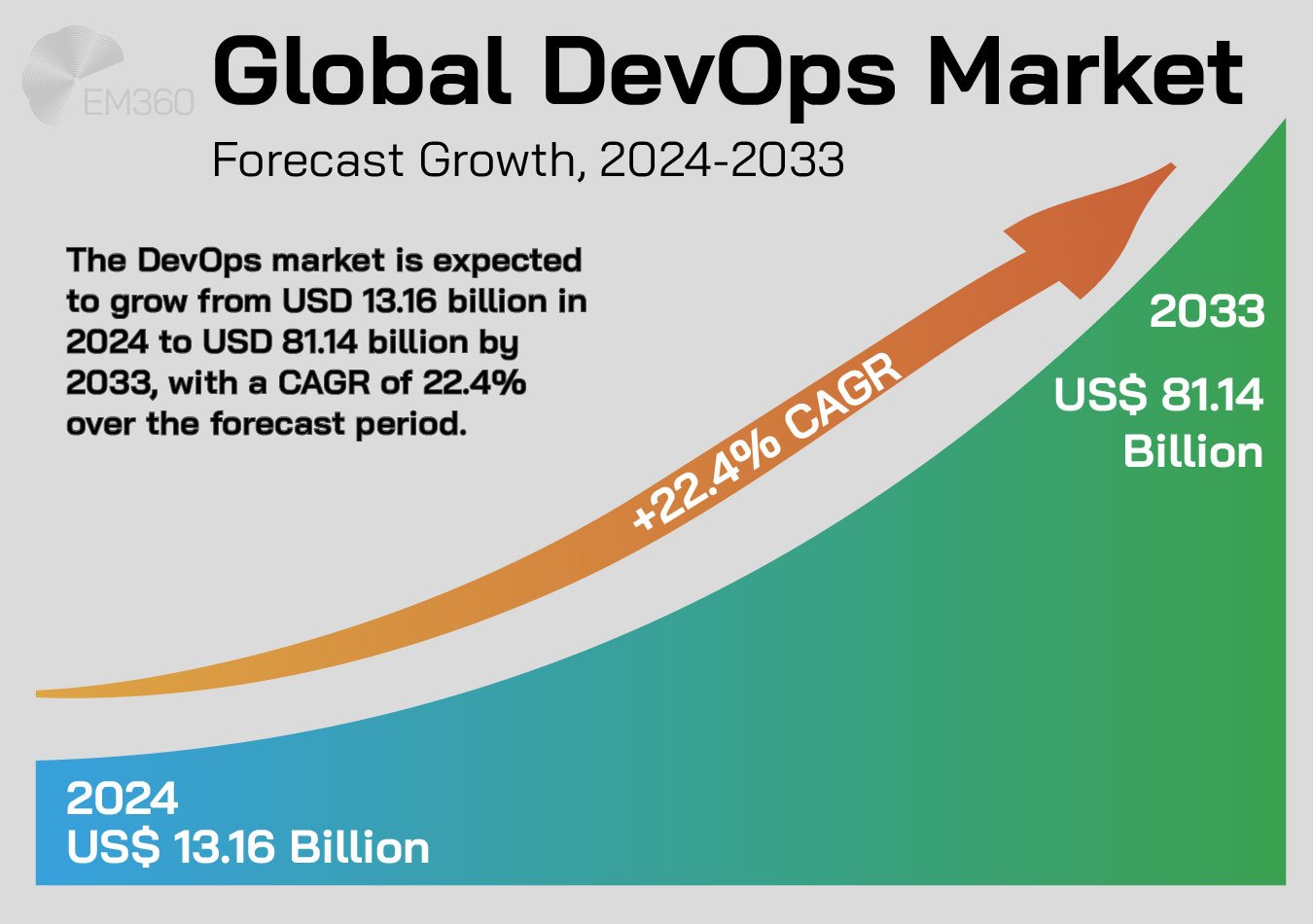
What Is a DevOps Engineer?
The term DevOps engineer is one of the most widely used — and most misunderstood — job titles in tech today. Depending on who you ask, it could refer to anything from a release manager to a site reliability engineer to an infrastructure automation specialist. And sometimes, it just means the person who gets paged when the system goes down.
But while the role varies from company to company, the core idea stays the same: DevOps engineers are the people who bring development and operations closer together.
They build the systems, pipelines, and processes that support rapid, secure, and dependable software delivery. And more importantly, they help teams work better together — across silos, departments, and disciplines.
What they do
DevOps engineers sit at the intersection of code and infrastructure — and their work reflects that blend.
They’re often responsible for designing and maintaining CI/CD pipelines, so new code can move from repository to production with speed and confidence. They manage cloud infrastructure, provision environments using Infrastructure as Code (IaC), and implement observability tools that help teams detect issues before users notice them.
But their role isn’t just technical. DevOps engineers also help establish the processes and cultural norms that support effective collaboration. That might mean leading post mortems, facilitating blameless incident reviews, or building tooling that improves developer experience.
In short: they’re glue. The kind that holds fast-moving teams together without slowing them down.
Skillsets and tools
Because the role spans development, operations, and everything in between, DevOps engineers tend to be versatile by design. They’re rarely deep specialists in just one area. Instead, they’re fluent in many — and adaptable across contexts.
Typical skillsets include:
- Scripting and automation (Python, Bash, PowerShell)
- Infrastructure as Code (Terraform, Ansible, CloudFormation)
- Containerisation and orchestration (Docker, Kubernetes)
- Monitoring and observability (Prometheus, Grafana, Datadog, New Relic)
- Cloud platforms (AWS, Azure, GCP)
- Communication and systems thinking — which are often harder to teach, but essential to success
And while the tooling shifts depending on stack and scale, the mindset stays consistent: reduce friction, improve flow, and make it easier for teams to deliver value.
Why the role is misunderstood
The biggest misconception about DevOps engineers is that they’re just developers who also run deployments. Or sysadmins who picked up some YAML. But the reality is far more nuanced.
Not every DevOps engineer codes full applications. Many focus more on infrastructure, orchestration, or team enablement than on feature development. What defines the role isn’t the specific tools they use or the amount of code they write — it’s the way they make consistent, resilient, and cross-functional software delivery possible.
It’s also easy to assume DevOps engineers work alone. But the strongest ones don’t just build tooling. They build bridges between teams, disciplines, intent and execution.
That’s what makes the role so valuable — and so hard to pin down.
Is DevOps Full of Coding?
It’s one of the most common misconceptions about DevOps — and one of the most limiting.
No, DevOps isn’t full of coding.
In fact, many DevOps practitioners don’t spend much of their time writing application code at all. Some write scripts. Some configure pipelines. Some don’t write code at all — and still play a critical role in helping teams move faster, safer, and more collaboratively.
That’s because DevOps isn’t defined by how much you code — it’s defined by how you enable software delivery.

The real heart of DevOps lies in how people think and work:
- Systems thinking — seeing the bigger picture and understanding how changes ripple across teams and environments
- Process design and automation — building repeatable workflows that reduce friction and risk
- Collaboration and communication — creating shared visibility and trust across development, operations, security, and the business
Whether someone is scripting deployments, coordinating incident response, managing IaC templates, or coaching teams on feedback loops, they’re practicing DevOps — even if they’ve never written a line of product code.
And the paths into DevOps are just as varied.
Some DevOps professionals come from traditional sysadmin or operations backgrounds. Others transition from QA, security, or network engineering. Some arrive from entirely different functions — product, project management, even sales or support — bringing a systems mindset and a talent for connecting people and processes.
What they have in common isn’t a specific tech stack. It’s a shared commitment to delivering better software through smarter teamwork.
So while coding can absolutely be part of the role — especially in scripting, infrastructure, and automation — it’s not the full story. Not even close.
AI in DevOps
AI is changing how we work — and DevOps is no exception.
From automating testing to predicting outages before they happen, artificial intelligence and machine learning are already reshaping DevOps workflows. But as AI’s role continues to expand, so do the questions:
Will AI replace DevOps engineers? Will the culture and collaboration DevOps relies on be replaced by algorithms and automation?
The short answer is no. But the long answer is where things get interesting.
How AI is supporting DevOps
AI isn’t replacing DevOps — it’s extending it.
Many high-performing teams are already using AIOps tools to enhance reliability, reduce noise, and speed up decision-making. These tools use machine learning models to identify patterns, surface anomalies, and trigger responses faster than humans can react alone.
In fact, Google’s 2024 State of DevOps report shows that 25% of organisations are now using AI in their DevOps workflows — with early adopters reporting improvements in productivity and job satisfaction, while burnout has been reduced.
It’s not just about speeding things up. It’s about giving teams better signal, more support, and fewer repetitive tasks.
Some examples of how AI is being used in DevOps environments today:
- Predictive analytics: Tools like Moogsoft and BigPanda monitor logs and metrics in real time to anticipate incidents before they escalate
- Anomaly detection: Dynatrace and New Relic use AI to filter alerts and isolate root causes across complex systems
- Test generation and prioritisation: Solutions like Testim and Functionize leverage AI to create smarter, faster, and more resilient automated test suites
These technologies aren’t replacing engineers. They’re amplifying what teams can see, automate, and respond to — helping them move faster without sacrificing stability.
Human-in-the-loop: Augmentation, not replacement
Even the most advanced AI systems can’t replace what makes DevOps truly work: context, trust, and culture.
AI can help you detect an issue. But it can’t interpret business impact, navigate trade-offs, or communicate across teams. It can speed up a deployment pipeline, but it can’t build the psychological safety that allows people to take risks, learn from failure, and improve.
That’s why DevOps will always need people at the centre — to ask the right questions, align priorities, and lead the conversations that AI can’t replicate.
In the future, we’ll see more AI-enabled DevOps. Smarter pipelines. More resilient infrastructure. Faster feedback. But we won’t see DevOps without humans — because DevOps isn’t just a process. It’s a practice. And practices don’t evolve without people.
Final Thoughts: Building For Velocity, Together
DevOps isn’t a static framework or passing trend. It’s a reflection of how modern businesses are learning to move — with speed, clarity, and collaboration at scale.
And while the tools and titles may change, the core remains: DevOps is about building the kind of systems — and teams — that can respond swiftly, operate with confidence, and keep evolving.
At EM360Tech, we spotlight the strategies, tools, and team dynamics shaping this transformation. From conversations with CIOs and cloud architects to deep dives on automation and security, we’ve seen how DevOps is helping organisations rethink delivery at every level.
If you’re navigating your own DevOps evolution — or just exploring what’s possible — we’re here to help you stay informed, aligned, and ahead of the curve.




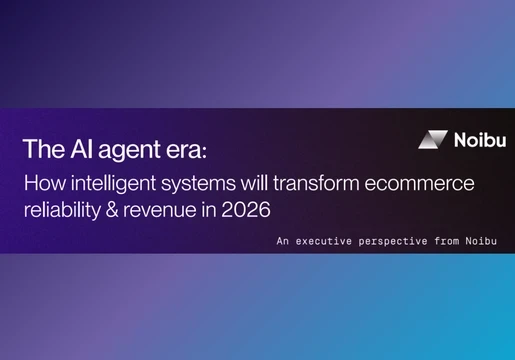


Comments ( 0 )